2012年美国风湿病学会痛风治疗指南评析
- 格式:pdf
- 大小:256.98 KB
- 文档页数:3

的,在T 2相上大部分是中等信号,少数为高信号,并且造影后呈现明显的强化。
这种强化可能和组织学上看到的周围“纤维血管区”中占优势的血管成比例。
在T 2加权像上的低信号点倾向于钙化灶。
6痛风、其他结晶性关节病和感染的影像学区别临床上,痛风的表现可以和感染性关节炎相似,包括发热,关节红肿热痛,血白细胞计数增多,血沉、C 反应蛋白升高;但痛风骨侵蚀的典型表现,易发作部位及缺乏邻近软组织化脓,有助于痛风诊断的征象。
抽取关节腔积液在偏振光显微镜见绿色针样晶体,革兰染色为阴性,将有助于痛风诊断。
关节软骨表面的MSU 结晶沉积物在超声中表现平行于骨皮质的回波曲线带,形成“双轨征”。
这是和焦磷酸钙结晶疾病有明显区别的征象,焦磷酸盐沉积症通常导致结晶沉积在关节内而不是关节表面。
超声为能检查出这些区别的最敏感的方式。
7影像学监测治疗效果随着更多新型、有效降尿酸方法的出现,人们尝试用影像学手段监测治疗疗效。
影像学变化包括痛风石的缩小、“双轨征”的消失、滑膜增生停止、关节渗出和骨髓水肿的改善。
CT 和MRI 采用先进的痛风石3D 绘图,使CT 和MRI 描述病变更加准确和逼真。
DECT 基于化学成分能识别尿酸结晶,在治疗随访中,观察溶解的痛风石方面更确切、可靠。
MRI 在随访滑膜增生和骨髓水肿方面有它特殊的价值,而超声是可以显示上述(除骨髓水肿外)所有影像表现的一种极好的廉价的方法,从而可以替代评估方法,并能提供精确的细节和良好的空间分辨率。
尽管MRI 在临床和科研方面同样有助于监测疾病进展,但随访不便捷且花费高。
因此,超声有望成为监测治疗反应的最佳方法。
综上所述,长期以来,影像学在诊断和随访痛风疗效方面价值十分有限,随着影像学技术的发展和临床案例探索,超声可用来指导穿刺获得组织样本,甚至在深部组织中寻找尿酸沉积物,从而有助于诊断。
准确地评估痛风的疾病活动性,并能有助于非典型急性痛风及伴痛风石的慢性痛风的诊断,同时评估治疗反应。
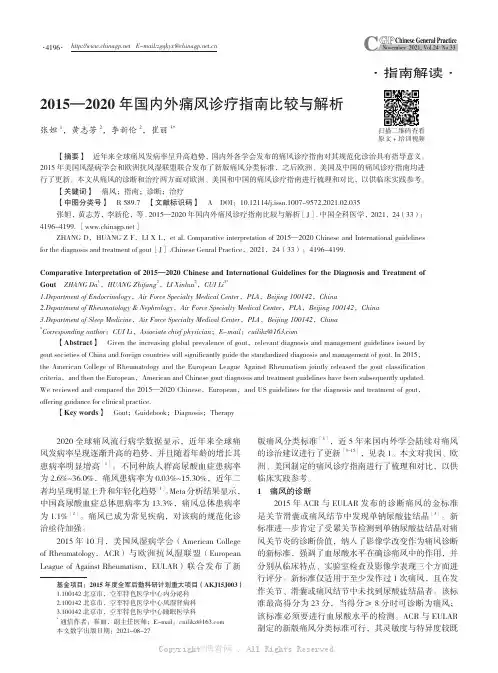
·4196··指南解读·2015—2020年国内外痛风诊疗指南比较与解析张妲1,黄志芳2,李新伦2,崔丽3*【摘要】 近年来全球痛风发病率呈升高趋势,国内外各学会发布的痛风诊疗指南对其规范化诊治具有指导意义。
2015年美国风湿病学会和欧洲抗风湿联盟联合发布了新版痛风分类标准,之后欧洲、美国及中国的痛风诊疗指南均进行了更新。
本文从痛风的诊断和治疗两方面对欧洲、美国和中国的痛风诊疗指南进行梳理和对比,以供临床实践参考。
【关键词】 痛风;指南;诊断;治疗【中图分类号】 R 589.7 【文献标识码】 A DOI:10.12114/j.issn.1007-9572.2021.02.035张妲,黄志芳,李新伦,等. 2015—2020年国内外痛风诊疗指南比较与解析[J].中国全科医学,2021,24(33):4196-4199. []ZHANG D,HUANG Z F,LI X L,et al. Comparative interpretation of 2015—2020 Chinese and International guidelines for the diagnosis and treatment of gout[J].Chinese Genral Practice,2021,24(33):4196-4199.Comparative Interpretation of 2015—2020 Chinese and International Guidelines for the Diagnosis and Treatment of Gout ZHANG Da 1,HUANG Zhifang 2,LI Xinlun 2,CUI Li 3*1.Department of Endocrinology ,Air Force Specialty Medical Center ,PLA ,Beijing 100142,China2.Department of Rheumatology & Nephrology ,Air Force Specialty Medical Center ,PLA ,Beijing 100142,China3.Department of Sleep Medicine ,Air Force Specialty Medical Center ,PLA ,Beijing 100142,China*Corresponding author :CUI Li ,Associate chief physician ;E-mail :【Abstract 】 Given the increasing global prevalence of gout,relevant diagnosis and management guidelines issued bygout societies of China and foreign countries will significantly guide the standardized diagnosis and management of gout. In 2015,the American College of Rheumatology and the European League Against Rheumatism jointly released the gout classification criteria,and then the European,American and Chinese gout diagnosis and treatment guidelines have been subsequently updated. We reviewed and compared the 2015—2020 Chinese,European,and US guidelines for the diagnosis and treatment of gout,offering guidance for clinical practice.【Key words 】 Gout;Guidebook;Diagnosis;Therapy版痛风分类标准[3],近5年来国内外学会陆续对痛风的诊治建议进行了更新[3-15],见表1。
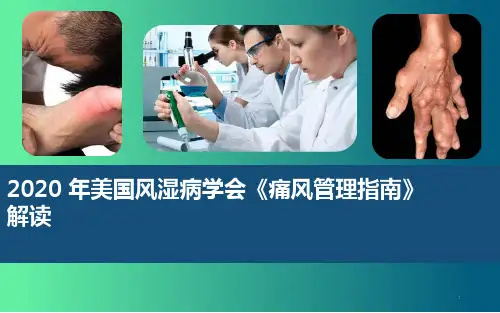
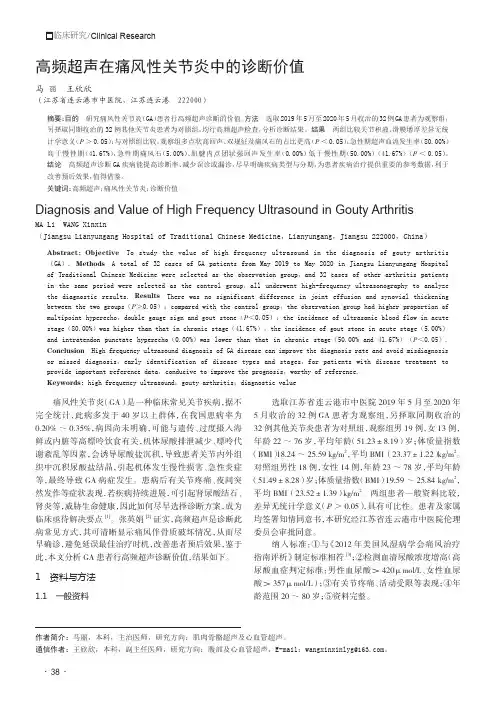
·38·□临床研究/Clinical Research高频超声在痛风性关节炎中的诊断价值马 丽 王欣欣 (江苏省连云港市中医院,江苏连云港 222000)摘要:目的 研究痛风性关节炎(GA)患者行高频超声诊断的价值。
方法 选取2019年5月至2020年5月收治的32例GA 患者为观察组,另择取同期收治的32例其他关节炎患者为对照组,均行高频超声检查,分析诊断结果。
结果 两组比较关节积液、滑膜增厚差异无统计学意义(P >0.05);与对照组比较,观察组多点状高回声、双规征及痛风石的占比更高(P <0.05);急性期超声血流发生率(80.00%)高于慢性期(41.67%),急性期痛风石(5.00%)、肌腱内点团状强回声发生率(0.00%)低于慢性期(50.00%)(41.67%)(P <0.05)。
结 论 高频超声诊断GA 疾病能提高诊断率、减少误诊或漏诊,尽早明确疾病类型与分期,为患者疾病治疗提供重要的参考数据,利于改善预后效果,值得借鉴。
关键词:高频超声;痛风性关节炎;诊断价值Diagnosis and Value of High Frequency Ultrasound in Gouty ArthritisMA Li WANG Xinxin(Jiangsu Lianyungang Hospital of Traditional Chinese Medicine,Lianyungang,Jiangsu 222000,China)Abstract:Objective To study the value of high frequency ultrasound in the diagnosis of gouty arthritis (GA). Methods A total of 32 cases of GA patients from May 2019 to May 2020 in Jiangsu Lianyungang Hospital of Traditional Chinese Medicine were selected as the observation group,and 32 cases of other arthritis patients in the same period were selected as the control group,all underwent high-frequency ultrasonography to analyze the diagnostic results. Results There was no significant difference in joint effusion and synovial thickening between the two groups(P >0.05);compared with the control group,the observation group had higher proportion of multipoint hyperecho,double gauge sign and gout stone(P <0.05);the incidence of ultrasonic blood flow in acute stage(80.00%)was higher than that in chronic stage(41.67%),the incidence of gout stone in acute stage(5.00%)and intratendon punctate hyperecho(0.00%)was lower than that in chronic stage(50.00% and 41.67%)(P <0.05). Conclusion High frequency ultrasound diagnosis of GA disease can improve the diagnosis rate and avoid misdiagnosis or missed diagnosis,early identification of disease types and stages,for patients with disease treatment to provide important reference data,conducive to improve the prognosis,worthy of reference.Keywords:high frequency ultrasound;gouty arthritis;diagnostic value作者简介:马丽,本科,主治医师,研究方向:肌肉骨骼超声及心血管超声。
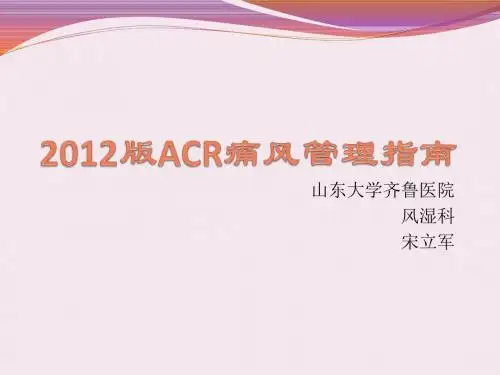
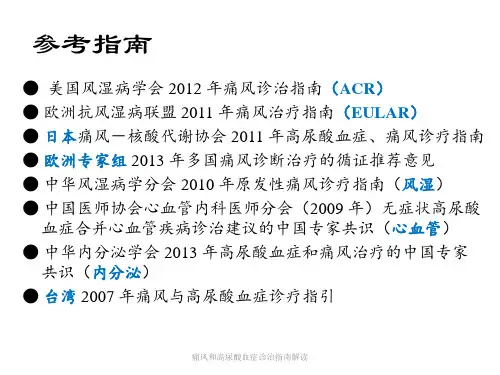
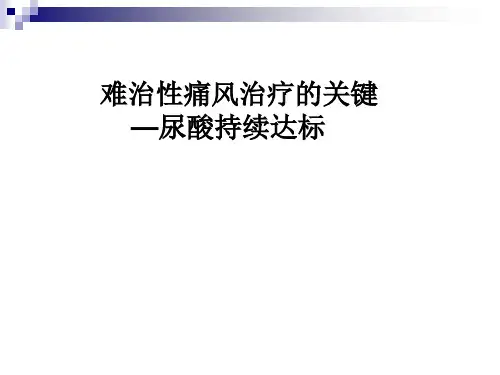

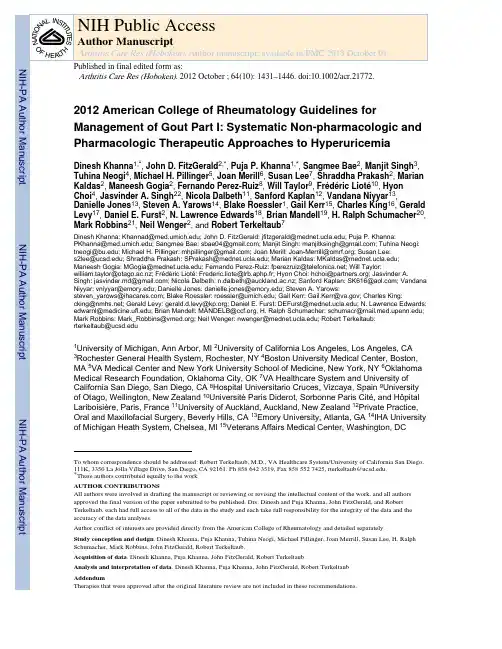
16North Mississippi Medical Center, Tupelo, MS 17Southern California Permanente Medical Group, Downey, CA 18University of Florida, Gainesville, FL 19Cleveland Clinic, Cleveland, OH 20University of Pennsylvania and VA Medical Center, Philadelphia, PA 21Harvard Vanguard Medical Associates/Atrius Health, Somerville, MA 22VA Medical Center. Birmingham, Alabama and University of Alabama, Birmingham, AL Keywords Allopurinol; Febuxostat; Probenecid; Pegloticase; Uricosuric; Xanthine Oxidase; Tophi INTRODUCTION Gout is a disorder that manifests as a spectrum of clinical and pathologic features built on a foundation of an excess body burden of uric acid, manifested in part by hyperuricemia,which is variably defined as serum urate greater than either 6.8 or 7.0 mg/dL (1;2). Tissue deposition of monosodium urate monohydrate crystals in supersaturated extracellular fluids of the joint, and certain other sites, mediates most of the clinical and pathologic features of gout. Typically, the disease first presents as arthritis that is acute and episodic, but can become recurrent in the majority of individuals. Gout also can manifest as chronic arthritis of one or more joints (1;2). Tophi, mainly in articular, periarticular, bursal, bone, auricular,and cutaneous tissues are a pathognomonic feature of gout, and are detectable by physical exam, and/or by imaging approaches and pathology examination (3;4;5). Renal manifestations of gout include urolithiasis, typically occurring with an acidic urine pH (1;2).Chronic interstitial nephropathy, mediated by monosodium urate monohydrate crystal deposition in the renal medulla, can occur in severe disease, but is currently considered to be an uncommon clinical manifestation of gout.Gout is one of the most common rheumatic diseases of adulthood, with self-reportedprevalence in the USA recently estimated at 3.9% of adults (~8.3 million people)(6).Prevalence of gout has risen in many countries (e.g., New Zealand), and especially in theUSA over the last few decades, mediated by factors such as increased prevalence of co-morbidities that promote hyperuricemia, including hypertension, obesity, metabolicsyndrome, type 2 diabetes, and chronic kidney disease (CKD)(7–10). Other factors in therising prevalence of gout include certain dietary trends and widespread prescription ofthiazide and loop diuretics for cardiovascular diseases (11). Many gout patients, includingthe growing subset of affected elderly, have complex co-morbidities and medication profilesthat complicate overall management (12). Long-term morbidity and impairment of health-related quality of life are now better appreciated in many gout patients, particularly thosewith multiple co-morbidities and/or chronic gouty arthritis (13;14). Despite advancedunderstanding of the molecular bases of hyperuricemia and gouty inflammation, and theextensive practice experience of many providers, substantial quality of care gaps exist ingout management (15). Moreover, significant shortfalls in patient education and adherencehave been identified in gout (16).On behalf of the American College of Rheumatology (ACR), we were charged withdeveloping systematic non-pharmacologic and pharmacologic recommendations foreffective treatments in gout with acceptable risk-benefit ratio. Our assignment was to focuson four specific domains in gout management. Two of these domains are addressed herein,(i) Urate-lowering therapy (ULT), and (ii) chronic gouty arthritis with tophaceous diseasedetected on physical examination (designated by the ACR with the terminology “chronictophaceous gouty arthropathy” (abbreviated CTGA), and specifically represented in theNIH-PA Author ManuscriptNIH-PA Author ManuscriptNIH-PA Author Manuscriptfundamental case scenarios 7–9 described herein). Domains iii-iv (analgesic and anti-inflammatory management of acute gouty arthritis, and pharmacologic anti-inflammatory prophylaxis of attacks of gouty arthritis, respectively) are addressed in a separate manuscript (Part II of the guidelines)(17).There are multiple lines of epidemiologic and experimental evidence that hyperuricemia, via effects of excess soluble urate, may play a role in some human renal, cardiovascular, and metabolic co-morbidities also frequently associated with gout (7–10). We did not address pharmacologic management of asymptomatic hyperuricemia, due to a paucity of prospective, randomized, controlled human research trials in that area (18).We were charged by the ACR with developing gout recommendations based on evidence as available, at an international level, for rheumatologists and other health care providers,including other subspecialists, primary care practitioners, nurse practitioners, physician assistants, and allied health professionals. The ACR requested that we apply the established Research and Development/University of California at Los Angeles (RAND/UCLA)Appropriateness Method (19) to generate recommendations, and engaged a diverse,international panel of experts. Creating novel classification of gout as a disease, new gout diagnostic criteria, or definition of treatment outcomes were beyond the scope of this work.Instead, we generated multifaceted case scenarios to elucidate decision-making based primarily on clinical and laboratory test-based data that can be obtained on a gout patient in an office practice setting.Guidelines for gout management have been generated in the last decade, at the national or multinational society level, by the European League Against Rheumatism (EULAR)(20;21),the Dutch College of General Practitioners (22), the Japanese Society of Gout and Nucleic Acid Metabolism (23), and the British Society for Rheumatology (BSR)(24). Moreover, the National Institute for Health and Clinical Excellence (NICE) single technology appraisal (STA) process has been applied to ULT in gout using febuxostat (25). New guidelines wererequested by the ACR, as the understanding of gout risk factors has been greatly augmented by recent clinical research (12). Moreover, ULT options recently increased via clinicaldevelopment, and drug regulatory agency approval of new pharmacologic agents (febuxostat and the biologic drug pegloticase)(26;27). New imaging approaches for gout that can detect radiographic changes of early disease not visualized by plain radiography (e.g., highresolution ultrasound, dual energy computed tomography (DECT)(28;29), are beinginvestigated for impact on gout diagnosis, and assessment of disease burden and severity,and choices and effectiveness of management. Developments such as these are considered in the work of this committee, which was built on several key assumptions (Table 1).The ACR gout guidelines are designed to emphasize safety, and quality of therapy, and to reflect best practice, as evaluated by a diverse group of experts that examine the level ofevidence available at the time. Importantly, societal cost of health care, and cost and cost-effectiveness differences between therapies are excluded from analysis by the RAND/UCLA Appropriateness Methodology (19) (Table 1). Individual results of this work are designated as “recommendations” rather than guidelines, in order to reflect the non-prescriptive nature of decision-making evaluated by experts, and based on available evidence at the time. The recommendations cannot substitute for individualized, direct assessment of the patient,coupled with clinical decision making by a competent health care practitioner. Treatment recommendations also assume appropriate attention to potential drug interactions (eg, with anticoagulants, azathioprine, amoxicillin), and effects of co-morbidities such as diabetes,and renal, cardiac, gastrointestinal, and hepatic disease (Table 1). The motivation, financial circumstances, and preferences of the gout patient play a very important role. Moreover, the NIH-PA Author ManuscriptNIH-PA Author ManuscriptNIH-PA Author Manuscriptrecommendations for gout management presented here are not intended to limit or denythird party payer coverage of health care costs for groups, or individual patients, with gout.METHODSProject design and development of recommendations and grading of evidence The overall design of the project is schematized in Supplemental Figure 1. The RAND/UCLA consensus methodology, developed in the 1980s, incorporates both Delphi and nominal group methods (19;30), and was successfully used to develop other guidelines commissioned by the ACR. The purpose of this methodology is to reach a consensus among experts, with an understanding that published literature may not be adequate to provide sufficient evidence for day-to-day clinical decision-making. The RAND/UCLA method requires 2 groups of experts—a core expert panel (CEP) that provides input into case scenario development and preparation of a scientific evidence report, and a task force panel (TFP) that votes on these case scenarios. Our CEP consisted of leaders for each domain (Supplemental Figure 2). Pharmacologic approaches, and diet, lifestyle and non-pharmacologic measures (e.g., weight loss, exercise) were addressed within each domain.The CEP leaders communicated with an international panel of gout experts, and the PIs, to develop initial case scenarios that reflect broad differences in severity of the disease and its clinical manifestations. In addition, there were weekly interactive teleconferences between domain leaders and PIs to refine case scenarios. Though previous systematic review for gout has been performed by EULAR, as a prime example, we performed our own systematic review of pertinent literature. The resultant scientific evidence report given to the TFP in conjunction with clinical scenarios representing a broad scope of disease, with multiple questions of interest, and alternative options, for each case scenario.By ACR mandate, the TFP had a majority of members without perceived potential conflict of interest (COI), and had diverse experience and expertise, as described in detail inSupplemental Figure 2. The TFP included 7 rheumatologists (one of whom is a Chair ofInternal Medicine, and one an Internal Medicine Residency Training Program Director), 2primary care physicians, a nephrologist, and a patient representative. There were 2 rounds of ratings, the first anonymously with the members of the TFP instructed to rank each of the potential elements of the guidelines on a risk-benefit basis ranging from 1 to 9 on a Likert scale using Delphi process, followed by a face-to-face group discussion and then re-voting of the same scenarios. A vote of 1–3 on the Likert Scale was rated as Inappropriate = risks clearly outweigh the benefits. A vote of 4–6 on the Likert Scale was considered Uncertain =risk-benefit ratio is uncertain. A vote of 7–9 on the Likert Scale was rated as Appropriate =benefits clearly outweigh the risks. Samples of votes taken and results are provided inSupplemental Figure 3. Votes on case scenarios were translated into recommendations if the median voting score was graded 7–9 (“appropriate”) and if there was no significantdisagreement, defined as no more than 1/3 of the votes graded (“inappropriate”) for thescenario. The final rating was done anonymously in a 2-day face-to-face meeting, facilitated by an experienced moderator (Neil Wenger). During the face-to-face TFP meeting, some case scenarios were clarified for content or verbiage, and re-voted on by the TFP.The level of evidence supporting each recommendation was ranked based on previousmethods used by the American College of Cardiology (31) and applied to recent ACRrecommendations (32;33). Level A grading was assigned to recommendations supported by multiple (i.e., more than one) randomized clinical trials or meta-analyses. Level B grading was assigned to the recommendations derived from a single randomized trial, ornonrandomized studies. Level C grading was assigned to consensus opinion of experts, case studies, or standard-of-care.NIH-PA Author ManuscriptNIH-PA Author ManuscriptNIH-PA Author ManuscriptSystematic reviewPubMed and Cochrane Central Register of Controlled Trials (CENTRAL) from the 1950s to the present were searched to find articles on gout with help of an experienced librarian(Rikke Ogawa). We used a search strategy based on the Cochrane Highly Sensitive Search Strategy for identifying randomized trials. The search was expanded to include articlesdiscussing research designs such as cohort, case control and cross sectional studies. Limits included English Language and the exclusion of “animal only” studies. The exact terms,process and results of the search are summarized in Supplemental Figure 4.Clinical Case DescriptionsThe TFP evaluated scenarios with a broad spectrum of clinical gout, similar to what aclinician might see in a busy practice, and divided into mild, moderate, and severe disease activity in each of three distinct “treatment groups” (Figure 1A–B). In generating these nine fundamental clinical case scenarios, mild disease activity levels in each “treatment group”were meant to represent patients at the lowest disease activity level for which mostclinicians would consider initiating or altering a specific medication regimen. Conversely,severe disease activity level was intended to represent patients with disease activity equal or greater to that of the “average” subject studied in a clinical trial. The case scenarios were not intended to serve as classification criteria. To allow the TFP to focus on managementdecisions, each case scenario had the assumption not only that the diagnosis of gout was correct, and that there was some clinical evidence of gout disease activity. This included intermittent symptoms of variable frequency, specifically presented to the TFP as episodes of acute gouty arthritis of at least moderate to severe pain intensity (17). Clinical evidence of gout disease activity, presented to the TFP, also included one or more tophi detected byphysical exam, or alternatively, chronic symptomatic arthritis (ie, “chronic arthropathy” or “synovitis”) due to gout, with or without confirmed joint damage (e.g., deformity, erosion due to gout on imaging study). Hyperuricemia was defined here as serum urate >6.8 mg/dL(2). We determined all aspects of case scenario definitions by a structured iterative process,using regular electronic mail, and teleconferences at least once per month. Multiplerevisions to the proposed parameters were carried out, until accepted by the CEP domain leaders.Definitions of pharmacologic therapeutic agentsMedication classes evaluated in the case scenarios were defined as follows: Xanthineoxidase inhibitor (XOI) refers to allopurinol or febuxostat; uricosuric agents were defined to include agents available in the USA (probenecid, and off-label use (as uricosuric therapy) of fenofibrate and losartan), but did not include sulfinpyrazone or benzbromarone. Other agents and modalities were self-explanatory. Evaluation by the TFP of effectiveness of a giventherapeutic option assumed that patients in case scenarios received the maximum tolerated typical dose for a period of time sufficient to accurately assess therapeutic response, unless otherwise indicated.Managing perceived potential COIPerceived potential COI was managed in a prospective and structured manner. Specifically,all participants intellectually involved in the project, whether authors or not, were required to fully, and prospectively disclose relationships with pharmaceutical companies with amaterial interest in gout (Supplemental Material Discussion). Disclosures were updatedevery 6 months, and for the PIs, CEP and TFP, updated just prior to the face-to-facemeeting. A summary listing of all perceived potential COI was disseminated to allparticipants in the project, and is available in the supplemental materials. Based on thepolicies of the ACR, which are aligned with those of many medical societies, no more than NIH-PA Author Manuscript NIH-PA Author Manuscript NIH-PA Author Manuscript49% of project participants could have COI at any given time. It was required that theproject PI (John FitzGerald) remain without perceived potential COI prior to and during the process.RESULTS Primary principles of management for all gout case scenarios The TFP generated recommendations for a systematic non-pharmacologic and pharmacologic management approach intended to be applicable to all patients with gout,which is summarized in Figure 3. This was based on the assumption that the diagnosis of gout was correct before initiation of management. The approach highlighted patient education on the disease and treatments and their objectives, and initiation of diet and lifestyle recommendations. The TFP also recommended elimination of prescription medication that were non-essential for the optimal management of co-morbidities (eg,hypertension, CHF, hyperlipidemia, or major organ transplant) in an individual patient,where such medication elevated serum urate levels; with prime examples being thiazide and loop diuretics, niacin, and calcineurin inhibitors (Evidence C). Though low dose acetylsalicylic acid (aspirin ≤ 325 mg daily) elevates serum urate, the TFP did not recommend discontinuation of this modality as cardiovascular disease prophylaxis in gout patients. In discussion, without a specific vote, the TFP viewed the relative risks specifically attributable to the modest effects of low dose aspirin on serum urate as negligible in gout management.The TFP recommended that clinicians consider causes of hyperuricemia for all gout patients,and recommended a specific co-morbidity checklist (Evidence C)(Table 2). In doing so, the TFP specially recommended consideration, and if indicated, medical evaluation of certain agents and disorders that cause uric acid underexcretion or overproduction, and thereby could merit laboratory investigations such as urinalysis, renal ultrasound, a completehemogram, or urine uric acid quantification as indicated. In this context, the TFPspecifically recommended screening for uric acid overproduction (by urine uric acidevaluation for uric acid overproduction), in patient subsets with gout clinical disease onset before age 25 (Evidence C), or a history of urolithiasis (Evidence C).The TFP provided guidance for referral to a specialist, with caution to avoid appearing self-serving. Though limited by the absence of outcomes data on potential benefits of referral,the TFP recommended that gout case scenarios including any of the following should be amongst those where referral to a specialist is considered (Evidence C for all): (i) Unclear etiology of hyperuricemia; (ii) Refractory signs or symptoms of gout; (iii) Difficulty inreaching the target serum urate level, particularly with renal impairment and a trial of XOI treatment; (iv) Multiple and/or serious adverse events from pharmacologic ULT.Clinical evaluation of gout disease activity and burdenThe TFP recommended clinical evaluation of gout disease symptom severity and burden in individual patients by history and thorough physical exam for symptoms of arthritis, and signs such as tophi and acute and chronic synovitis (Evidence C). To be actionable byclinicians, the authors, without a specific TFP vote, suggest that clinicians can work with patients to record and estimate the number per year, and severity (17) of acute attacks of gouty arthritis per year.Core recommendations for non-pharmacologic ULT measures in goutThe TFP recommended certain diet and lifestyle measures for the vast majority of patients with gout (Evidence B-C for individual measures) (Figure 4). Many of the diet and lifestyle NIH-PA Author ManuscriptNIH-PA Author ManuscriptNIH-PA Author Manuscriptmeasures were recommended for decreasing the risk and frequency of acute gout attacks(12) and lowering serum urate, but the primary emphasis of the TFP recommendations in Figure 4 was on diet and lifestyle choices for promotion and maintenance of ideal health,and prevention and optimal management of life-threatening comorbidities in gout patients,including coronary artery disease (34,35), and obesity, metabolic syndrome, diabetes,hyperlipidemia, and hypertension.Dietary recommendations were grouped into 3 simple qualitative categories, termed “limit”,“avoid”, or “encourage” (Figure 4). This approach, with rare exceptions (36,37), reflected a general lack of specific evidence from prospective, blinded, randomized clinical intervention trials that linked consumed quantities of individual dietary components to changes in either serum urate levels or gout outcomes. Notably, the replication of hazardous lifestyle riskfactors in a conventional clinical research trial would potentially pose both design andethical difficulties. As such, the TFP deliberated on evidence regarding the impact ofexposures to alcohol or purine-rich foods in a short time frame. The evidence sources were epidemiologic studies of hyperuricemia and incident gout, including long-term prospective analyses and internet-based case-crossover studies. The TFP recommended that goutpatients limit their consumption of purine-rich meat and seafood (Evidence B) as well as high fructose corn syrup sweetened soft drinks and energy drinks (Evidence C), andencouraged the consumption of low-fat or non-fat dairy products (Evidence B) (38)(Figure4). The TFP also recommended reduced consumption of alcohol (particularly beer, but also wine and spirits), and avoidance of alcohol overuse in all gout patients (Evidence B) (Figure4). The TFP further recommended abstinence from alcohol consumption for gout patients during periods of active arthritis, especially with inadequate medical control of the disorder and in CTGA (Evidence C)(39). Significantly, in discussion by the TFP, without a specific vote, the TFP recognized that diet and lifestyle measures alone provide therapeuticallyinsufficient serum urate-lowering effects and/or gout attack prophylaxis for a large fraction of individuals with gout (12). For example, some clinical trials on diet and fitness havereported only ~10–18% decrease in serum urate (38). In further discussion by the TFP, again without a specific vote, the TFP viewed this degree of serum urate-lowering as beneficial for all case scenarios, but insufficient to achieve an effective serum urate target in those with sustained hyperuricemia substantially above 7 mg/dL.Core recommendations for pharmacologic ULT, including the serum urate targetHere, and with all other recommendations for drug therapy in Parts I and II of the 2012 ACR Guidelines for gout, the recommendations assumed a lack of contra-indications, intolerance,serious adverse events, or drug-drug interactions for given agents. The TFP recommended gout with CKD stage 2–5, or end stage renal disease (ESRD), as an appropriate indication,by itself, for pharmacologic ULT (Evidence C) in patients with prior gout attacks andcurrent hyperuricemia. In pharmacologic ULT, certain treatment choices (e.g., probenecid)and drug dosing decisions (e.g., allopurinol) are impacted by the creatinine clearance. The TFP, without a direct vote, discussed and recognized the clinical value of accuratemeasurement of creatinine clearance, not simply the serum creatinine, in ascertaining the degree of renal impairment. However, the scope of the project did allow for detailed,prescriptive recommendations regarding specific ULT drug doses, or usage of individual agents in the presence of a given degree of either renal impairment, or other co-morbidities such as hepatic impairment.TFP recommendations for pharmacologic ULT, presented graphically in Figure 3, included recommendation of xanthine oxidase inhibitor (XOI) therapy with either allopurinol orfebuxostat as the first line pharmacologic approach (Evidence A). The panel did notpreferentially recommend either XOI over the other XOI drug. In doing so, the TFP weighed the lack of published safety data for febuxostat in the setting of stage 4 or worse CKD.NIH-PA Author Manuscript NIH-PA Author Manuscript NIH-PA Author ManuscriptProbenecid was recommended as an alternative first line pharmacologic ULT option, in the setting of contra-indication or intolerance to at least one XOI agent (Evidence B). However,the TFP did not recommend probenecid as a first line ULT monotherapy in those with acreatinine clearance below 50 ml/min.The TFP recommended that pharmacologic ULT could be started during an acute goutattack, providing that effective anti-inflammatory management has been instituted (EvidenceC). The TFP recommended regular monitoring of serum urate (every 2–5 weeks) duringULT titration, including continuing measurements once the serum urate target is achieved (every 6 months) (Evidence C). The TFP weighed this measure as particularly useful tomonitor adherence, given that poor adherence to ULT is a common problem in gout patients(16).The TFP recommended that the goal of ULT is to achieve a serum urate target, at aminimum, of < 6 mg/dL in all gout case scenarios (Evidence A). Moreover, the TFPrecommended that the target serum urate should be lowered sufficiently to durably improve signs and symptoms of gout, including palpable and visible tophi detected by physicalexamination, and that this may involve therapeutic serum urate-lowering to below 5 mg/dL (Evidence B).Recommendations specific to allopurinol dosing and pharmacogenetics TFP recommendations for use of allopurinol in gout are summarized in Table 3A.Importantly, the TFP recommended that the starting dose of allopurinol be no greater than 100 mg per day (Evidence B)(40), consistent with prior FDA and EULAR guidelines (21).The rationale of the TFP was partly that a low allopurinol starting dose could reduce early gout flares after ULT initiation, (26), and partly as a component of risk management with respect to the potential for severe hypersensitivity reaction to allopurinol (40), discussed in further detail below. The TFP recommended gradual upward titration of the allopurinolmaintenance dose every 2–5 weeks to an appropriate maximum dose for gout, in order to treat to the serum urate target appropriate for the individual patient (Evidence C).The TFP weighed robust evidence that allopurinol monotherapy at doses of 300 mg daily or less failed to achieve the serum urate target of <6 mg/dL (26,41), or < 5 mg/dL (42,43), in more than half of subjects with gout. The TFP reviewed small studies in which theallopurinol dose was titrated above 300 mg daily in gout with overall success in achieving the serum urate target (43,44). Importantly, in doing so, the TFP also recommended that the maintenance dose of allopurinol can be raised above 300 mg per day, even in those withrenal impairment, provided there is adequate patient education and regular monitoring for drug hypersensitivity and other adverse events, such as pruritis, rash, and elevated hepatic transaminases, as well as attention to potential development of eosinophilia (Evidence B).The TFP next considered the issue of measures to reduce the incidence of severe allopurinol hypersensitivity reactions, here termed allopurinol hypersensitivity syndrome (AHS). TFP discussion recognized the potential for hospitalization and severe morbidity, and thereported mortality rate of 20–25% in AHS (45,46). The estimated incidence of AHS is~1:1000 in the USA and its spectrum includes not only Stevens-Johnson Syndrome andToxic Epidermal Necrolysis, but also systemic disease with a clinical constellation offeatures such as eosinophilia, vasculitis, rash, and major end-organ disease (47). Concurrent thiazide use and renal impairment have been implicated as risk factors for AHS (48–50). A widely employed risk management strategy has been a non-evidence-based algorithm for allopurinol maintenance dosing, calibrated to renal impairment (51)(Evidence C);importantly, the TFP did not recommend this strategy,NIH-PA Author ManuscriptNIH-PA Author ManuscriptNIH-PA Author Manuscript。
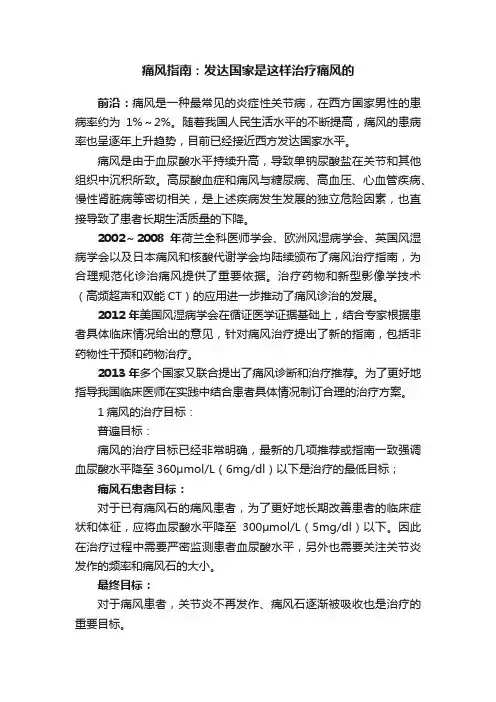
痛风指南:发达国家是这样治疗痛风的前沿:痛风是一种最常见的炎症性关节病,在西方国家男性的患病率约为1%~2%。
随着我国人民生活水平的不断提高,痛风的患病率也呈逐年上升趋势,目前已经接近西方发达国家水平。
痛风是由于血尿酸水平持续升高,导致单钠尿酸盐在关节和其他组织中沉积所致。
高尿酸血症和痛风与糖尿病、高血压、心血管疾病、慢性肾脏病等密切相关,是上述疾病发生发展的独立危险因素,也直接导致了患者长期生活质量的下降。
2002~2008年荷兰全科医师学会、欧洲风湿病学会、英国风湿病学会以及日本痛风和核酸代谢学会均陆续颁布了痛风治疗指南,为合理规范化诊治痛风提供了重要依据。
治疗药物和新型影像学技术(高频超声和双能CT)的应用进一步推动了痛风诊治的发展。
2012年美国风湿病学会在循证医学证据基础上,结合专家根据患者具体临床情况给出的意见,针对痛风治疗提出了新的指南,包括非药物性干预和药物治疗。
2013年多个国家又联合提出了痛风诊断和治疗推荐。
为了更好地指导我国临床医师在实践中结合患者具体情况制订合理的治疗方案。
1痛风的治疗目标:普遍目标:痛风的治疗目标已经非常明确,最新的几项推荐或指南一致强调血尿酸水平降至360μmol/L(6mg/dl)以下是治疗的最低目标;痛风石患者目标:对于已有痛风石的痛风患者,为了更好地长期改善患者的临床症状和体征,应将血尿酸水平降至300μmol/L(5mg/dl)以下。
因此在治疗过程中需要严密监测患者血尿酸水平,另外也需要关注关节炎发作的频率和痛风石的大小。
最终目标:对于痛风患者,关节炎不再发作、痛风石逐渐被吸收也是治疗的重要目标。
2痛风的诊断:在关节积液或痛风石中发现单钠尿酸盐晶体仍然是诊断痛风的最有利依据。
临床发现典型痛风石或对秋水仙碱治疗反应好,支持痛风诊断,除此以外的多数情况下,临床、实验室以及传统X线检查对于诊断的帮助不大。
对于11项研究的荟萃分析显示:新型影像学技术(超声、双能CT)对于痛风诊断有帮助。
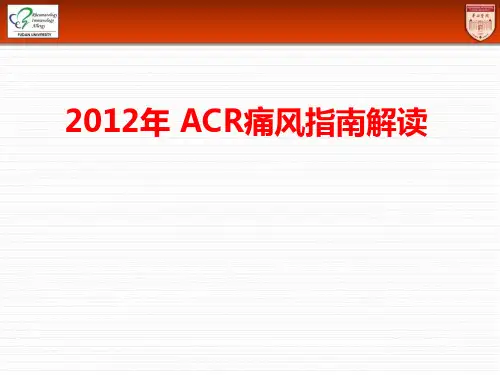
急性痛风性关节炎的药物治疗及选择作者:于一云等来源:《上海医药》2015年第11期摘要痛风是由嘌呤代谢障碍引起的一种代谢性疾病。
急性痛风性关节炎是痛风的最常见首发症状,传统治疗药物包括非甾体抗炎药物、秋水仙碱和糖皮质激素。
炎性细胞因子在急性痛风性关节炎的发病中起着重要作用,故能阻断炎症介质如白介素-1、肿瘤坏死因子-α等的生物制剂有望在该疾病治疗中得到广泛的应用。
本文就急性痛风性关节炎的药物治疗作一概要介绍。
关键词急性痛风性关节炎药物治疗生物制剂中图分类号:R971.1; R589.7 文献标识码:A 文章编号:1006-1533(2015)11-0014-05Abstract Gout is a kind of metabolic disease caused by purine metabolic disorders. Acute gouty arthritis (AGR) is usually the initial symptom for gout. Traditional medicines for the treatment of AGR include non-steroid anti-inflammatory drugs, colchicines, corticosteroids. Inflammatory cytokines play an key role in the pathogenesis of AGR, therefore, biologicals that can block inflammatory cytokines such as interleukin-1, tumor necrosis factor-α are expected to be widely used in the treatment of AGR. Here we mainly review medicine treatment of AGR and hope it can provide some help for further research.key words acute gouty arthritis; medicine treatment; biologicals痛风是由于遗传性或获得性病因导致嘌呤代谢紊乱和(或)尿酸排泄减少所引起的一组疾病,是由尿酸钠或尿酸结晶从超饱和的细胞外液沉积于组织所引起的有1种或多种病变的临床综合征。
世界各国的痛风指南比较近年来随着生活水平的提高和生活方式的改变,历史上的富贵病痛风的发病率越来越高,在我国其发病率从1998年的0.33%上升到2003年的1.34%,成为风湿科门诊的常见病。
与此同时,近些年医学界对痛风进行了大量的研究,在痛风的治疗策略、新药的研发及传统药物的用法等很多方面都取得了很大进展。
各个国家先后发布了痛风的诊治指南,包括2010年中国指南、2011年EULAR指南、2012年ACR指南等。
下面通过对各国痛风指南比较的角度,来再次理解痛风的诊治。
由于发布时间不同,研究背景不同,各个国家的痛风指南有相同的地方,也有不同的地方。
总的来说,对于痛风的治疗策略是一致的,都从单纯的镇痛治疗,转变为疾病的综合管理,均强调非药物治疗的重要作用。
非药物治疗包括饮食指导,戒烟,减肥,治疗合并症等情况。
ACR指南还特别强调患者教育还应包括痛风急性发作的识别及自我用药,更有利于尽早控制症状。
药物治疗主要包括以下几个方面。
一、急性期的药物治疗痛风急性发作期需要给予抗炎镇痛药物治疗,且应及早足量应用,在这一观点上,各国指南的观点是一致的,但药物选择上有所不同。
我国指南推荐一线用药为秋水仙碱、NSAIDS类药物,不包括糖皮质激素。
ACR和EULAR指南推荐一线药物为秋水仙碱、NSAIDS类药物及糖皮质激素,且认为三者没有优先推荐,临床上应根据患者的喜好、禁忌情况及先前的治疗反应等方面进行选择。
最近的一项系统回顾研究发现NSAIDS类药物包括COX-2抑制剂,糖皮质激素、秋水仙碱治疗急性痛风均有效,除此之外发现ACTH、白介素1受体拮抗剂卡纳单抗也有效,该系统回顾共纳入了30项RCT研究。
秋水仙碱是治疗急性痛风发作的传统药物,但其用法有较大变革。
2010年我国指南发布时,仍推荐传统大剂量用法。
但2011年的EULAR指南和2012年的ACR指南均推荐小剂量用法(负荷量1.2mg,1h后0.6mg,12h后给予预防用剂量0.6mg Qd/bid,直到缓解)。
【摘要】对比2012年美国风湿病学会(ACR ),2016年欧洲抗风湿病联盟(EULAR ),2016年中华医学会风湿病学分会(CRA ),2017年英国风湿病协会(BSR )的痛风指南和2018年中国台湾多学科工作组制定的专家共识的推荐要点,从患者教育、饮食和生活方式、急性痛风发作的管理、降尿酸药的合理应用、预防急性痛风复发5个方面分析,以供临床实践中参考。
【关键词】痛风指南诊治吴华香,医学博士,主任医师,博士生导师,现任浙江大学医学院附属第二医院风湿科主任,浙江省医师协会风湿免疫科医师分会会长,浙江省医学会风湿病学分会第一届委员会主任委员,中国医师协会风湿免疫科医师分会常委,中华医学会风湿病学分会第6、7、9届委员,第8届常委,中国医师协会免疫吸附学术委员会副主任委员。
《中华风湿病学杂志》、《浙江医学》等杂志编委。
从事临床、教学和科研工作三十年。
对痛风、系统性红斑狼疮、类风湿关节炎、强直性脊柱炎、干燥综合征、骨质疏松症等风湿病的诊断和治疗积累了丰富的临床经验。
主持和参与国家自然基金等国家级项目9项、省级课题5项,发表论文70余篇,SCI 论文14篇,参与的项目获得国家科技进步二等奖、浙江省科技奖一等奖和浙江省中医药科学技术奖一等奖,浙江省科学技术进步奖一等奖。
痛风是一种尿酸盐(MSU )沉积所致的晶体相关性关节病,是一种炎症性疾病,与嘌呤代谢紊乱及(或)尿酸排泄减少所致的高尿酸血症直接相关。
痛风患病率在全球范围内呈上升趋势。
中国等发展中国家经济处于上升期,生活水平不断提高和饮食结构改变导致近年来痛风和(或)高尿酸血症患者不断上升。
关于高尿酸血症及痛风的规范治疗越来越受人们重视。
近年来世界各地陆续出台或更新了原发性痛风的诊疗指南。
本文比较了2012年美国风湿病学会(ACR )[1-2]、2016年欧洲抗风湿病联盟(EULAR )[3]、2016年中华医学会风湿病学分会(CRA )[4]、2017年英国风湿病协会(BSR )[5]和2018年中国台湾多学科工作组[6]制定的痛风指南或专家共识,分析各个指南的异同点,进一步理清思路。
J Intern Med Concepts Pract 2012,Vol.7,No.6随着生活水平的不断提高,饮食结构的改变,痛风已由“帝王病”(king ’s disease )转变为“病中之王”(king of the dis -eases )。
之前,包括欧洲、日本、中国等都先后发布了痛风治疗指南,2012年10月,美国风湿病学会(American College ofRheumatology ,ACR )正式发布了2012年ACR 痛风治疗指南(以下简称指南)。
与之前其他国家、组织发布的指南相比,该指南包含了许多新的内容,值得研究、思考。
本文在介绍2012年ACR 痛风治疗指南的同时,对其内容作一评析。
指南分为两部分。
第1部分主要针对降尿酸治疗和慢性痛风石性痛风的治疗;第2部分针对镇痛治疗、抗炎治疗和痛风性关节炎发作的抗炎药物预防[1-2]。
流行病学目前美国成年人痛风患病率为3.9%,全美约有830万痛风患者。
痛风患者增多的原因主要与促发高尿酸血症的合并症[高血压、肥胖、代谢综合征、2型糖尿病、慢性肾功能不全(CKD )]患病率增加,以及饮食习惯改变,噻嗪类利尿剂、袢利尿剂使用增多有关。
中国等发展中国家经济处于上升期,生活水平不断提高和饮食结构改变是导致近年来痛风和(或)高尿酸血症患病率不断上升的主要原因。
美国等西方发达国家经济水平发展到相对平稳阶段,饮食结构基本上已经处于稳定状态,引发高尿酸血症的合并疾病以及药物因素则可能是导致痛风患病率不断上升的主要因素。
患者宣教和合并症处理对患者进行宣教,包括饮食指导、提倡良好的生活方式、告知患者治疗的目标,同时积极治疗可导致高尿酸血症的合并疾病是治疗的核心内容之一。
对患者进行积极有效的宣教是慢性疾病治疗的重要环节。
欧洲抗风湿联盟(EULAR )会议上流行病学调查数据显示:痛风患者在疾病认识上广泛存在误区,缺乏规范降尿酸治疗的知识,而且患者用药依从性较差。
家庭医师及非风湿科专科医师亦缺乏规范治疗的概念。
因此,指南特别强调宣教的重要性。
指南同时提出积极控制可导致高尿酸血症的合并疾病是预防、治疗痛风的重要环节,值得重视。
降尿酸治疗黄嘌呤氧化酶抑制剂(xanthine oxidase inhibitor ,XOI )别嘌醇和非布索坦(febuxostat )是首选的降尿酸药物。
降尿酸治疗应使症状、体征得到有效的、持续的改善,尿酸水平至少应降至<357μmol/L (6mg/dL ),一般应<297.5μmol/L (5mg/dL ),或者说对所有痛风患者降尿酸目标是血尿酸<357μmol/L ,但对于有痛风石的患者,应该降至297.5μmol/L 以下。
别嘌醇的起始剂量不应超过100mg/d ,中、重度CKD 患者应从更小剂量(50mg/d )开始,然后逐渐增加剂量,找到适合的维持剂量。
维持剂量可超过300mg/d ,甚至在CKD 患者中也可超过此剂量。
对于服用剂量大于300mg/d 的患者,应该注意瘙痒、皮疹和肝酶增高,可尽早发现严重药疹。
对于特定的人群,如韩国裔,同时有3级以上CKD ,及所有中国汉族人、泰国裔,因为人类白细胞抗原(HLA )-B*5801阳性率高,发生别嘌醇相关的严重过敏性药疹危险性增高,在使用别嘌醇前,应该进行HLA -B*5801快速PCR 检测。
如果单一的XOI 在增加到适当剂量后仍不能达到治疗目标(达标),可以联合使用一种促进尿酸排泄药物(urico -suric )。
这些药物包括丙磺舒、非诺贝特(非适应证用药)、氯沙坦(非适应证用药),但不包括磺吡酮和苯溴马隆。
在痛风急性发作期,如果已经使用抗炎药物,则可以开始降尿酸治疗。
在指南中强调了达标治疗的理念,明确提出了降尿酸治疗的目标值,对于治疗效果的评判以及保证患者病情长期稳定具有非常重要的意义。
对伴有痛风石的患者制定更为严格的治疗目标,有利于痛风石的吸收。
降尿酸药物首选XOI 别嘌醇和非布索坦,而在中国广泛使用的苯溴马隆未被推荐。
主要原因是美国曾发现服用苯溴马隆后导致肝功能衰竭,因此该药被美国食品药品管理局(FDA )禁止使用,目前美国市场已无供应。
另外一个原因是美国人群中HLA -B*5801阳性率明显低于一些亚裔人群,在亚裔人群中易发生的别嘌醇相关的严重药疹并不多·指南与解读·2012年美国风湿病学会痛风治疗指南评析邹和建1,3,姜林娣2,3(1.复旦大学附属华山医院风湿科,上海200040;2.复旦大学附属中山医院风湿科,上海200040;3.复旦大学风湿、免疫、过敏性疾病研究中心,上海200040)关键词:风湿病;痛风;治疗中图分类号:R593.2文献识别码:A文章编号:1673-6087(2012)06-0458-03DOI:10.3969/j.issn.1673-6087.2012.06.016基金项目:上海市优秀学术带头人计划项目编号:(11XD1401100);上海市科委基础研究重大项目(项目编号:11DJ1400100)458··内科理论与实践2012年第7卷第6期见,因此有条件将别嘌醇作为首选药物。
非布索坦是近年上市的新型XOI,其降尿酸作用与别嘌醇相当或略优,研究表明该药物导致的药疹明显低于别嘌醇,因此有广阔的市场前景。
但目前非布索坦在中国尚未上市,即便在美国和欧洲各国,药价依然非常昂贵,该药和别嘌醇同时被选为首选降尿酸药物,显然只是出于临床疗效的考虑,并未考虑药物经济学因素。
这一点在指南中也坦承告知。
由于我国别嘌醇引起的严重药疹发生率相对较高,苯溴马隆引起的严重肝功能损害相对少见,另外非布索坦目前未在我国上市,在降尿酸药物的选择上应考虑与ACR指南的差异。
别嘌醇相关的严重药疹与HLA-B*5801密切相关已经得到肯定。
在部分亚裔人群中,由于该基因的阳性率较高,因此一直为亚裔痛风患者用药顾虑。
早在2008年,中国台湾地方行政部门就已经发布指令,在服用别嘌醇前必须进行HLA-B*580检测。
但是在亚裔患者中,该基因检测并未广泛开展。
此次指南特别强调了HLA-B*5801检测的重要性。
我们的研究小组1年前成功研发了HLA-B*5801快速PCR检测方法,并且申报了发明专利,目前已经在向产品转化中,相信不远的将来,该项检测将成为可能。
别嘌醇的使用应该从小剂量开始,主要是出于以下考虑:小剂量开始可以减少诱发痛风发作的可能;别嘌醇相关的严重药疹与药物剂量相关。
2010年版中国痛风诊疗指南也提出应从100mg/d剂量起始,但是在实际工作中,尤其在基层医院和非专科医师中常被忽视。
对于使用足量XOI后仍不能达标的患者,可以合并使用促进尿酸排泄的药物,在国内,该观点也较早被接收。
但是合并哪种药物,什么时候开始合并用药仍值得注意。
何为足量?我们认为应该是药物说明书所载的最大允许剂量,但是应该充分考虑最大剂量时可能出现的不良反应,对于肾功能不全的患者更应谨慎。
非诺贝特、氯沙坦等药物原本并非用于降尿酸治疗,但在使用中发现这几种药物有利于促进肾脏尿酸的排泌,因此高尿酸血症患者在选择降脂药、降压药时,应优先选择这些药物。
但是在痛风患者中,不推荐单独采用这些药物来进行降尿酸治疗,而可与XOI合并使用,以提高降尿酸治疗效果。
国际上一些痛风治疗指南(包括中国指南)大多认为:降尿酸治疗均应在急性发作平息至少2周后方可开始,理由是急性痛风发作期采用降尿酸治疗可能会加重痛风的症状。
指南首次提出,在有效抗炎药物“保护”下,降尿酸治疗并非禁忌。
这一新观点值得在以后的临床实践中加以验证。
促尿酸排泄药物如果采用单药治疗,丙磺舒是促尿酸排泄药物的首选;非诺贝特、氯沙坦具有治疗性降尿酸作用;有尿路结石病史者禁用促尿酸排泄药作为单药治疗;在使用促尿酸排泄药物前,应该测定尿尿酸水平,在治疗过程中也应该随访;在治疗中应保证足量水分摄入,碱化尿液,检测尿pH值。
指南未将促尿酸药物作为首选,这符合从源头着手的思想。
但是也有部分患者对XOI无效或者不能耐受,仍有机会采用促尿酸排泄的药物。
因为前述原因,未推荐使用苯溴马隆。
强调促尿酸排泄药物使用中碱化尿液的重要性,因为药物使用过程中有更多的尿酸从肾脏排出,碱化尿酸可增加尿酸的溶解量,可防止尿酸盐晶体在肾脏的沉积或者形成结石。
尿尿酸的测定对于选择该类药物以及评价治疗效果具有重要的作用。
正常人尿尿酸一般<600mg/d,尿尿酸水平不高者适合采用促尿酸排泄药物,但尿尿酸明显增高时则不宜采用该类药物治疗。
尿酸酶和合并用药对于严重痛风患者,如果对传统降尿酸治疗耐药或者不能耐受,可以使用尿酸酶普瑞凯希(pegloticase)治疗,但是对用药周期多长,目前缺乏共识。
在痛风患者中,为了预防心血管疾病危害而服用小剂量阿司匹林者,不要求停止服用。
尿酸酶可以直接分解体内过多的尿酸,是痛风降尿酸治疗的新选择。
该药为生物制剂,价格昂贵,其可能导致的过敏、耐药是生物制剂的共同特点,因此被推荐为二线药物。
小剂量阿司匹林可以抑制肾小管对尿酸的排泌,被认为是引起高尿酸血症的重要诱因。
之前,对于痛风但需服用阿司匹林者,医师往往建议患者服用其他抗凝药物作为替代。
指南提出,对于已经发生痛风的患者,阿司匹林所起的负面作用是可以忽略的,因此不必中止用药或换药,这一新观点对于以后的临床实践具有指导意义。
肾功能不全者降尿酸治疗对于2~5级CKD或者终末期肾病患者,如果有过痛风发作、目前有高尿酸血症,就应该进行降尿酸治疗;对于肾功能不全的评估,内生肌酐清除率(Ccr)比血肌酐更为重要;由于没有非布索坦对4级或4级以上CKD患者用药安全性的资料,可以用丙磺舒作为一线药物;对于Ccr<50mL/ min者,不推荐单独采用丙磺舒作为一线药物。
一方面肾功能不全可以是长期痛风的并发症,另一方面各种肾病或者系统疾病引起的肾功能不全也可以导致继发性痛风发生。
肾功能不全患者降尿酸治疗一直是棘手的问题。
指南对于肾功能不全患者用药的提示显得非常重要。
血尿酸监测血尿酸监测对于痛风治疗是必需的。
在调整降尿酸药物过程中每2~5周测定1次。
在达标后(血尿酸<357μmol/ L)也要每6个月测定1次。
尿酸测定是调整药物剂量的依据,也有利于判断患者对治疗药物的依从性。
痛风患者治疗过程中血尿酸监测的重要性已得到普遍认同[3]。
但监测时间间隔没有明确规定。
指南明确提出了血尿酸监测周期,尤其是在降尿酸药物使用过程中每2~5周检测1次,与推荐的每2~5周进行1次药物剂量的调整相吻合。
459··J Intern Med Concepts Pract2012,Vol.7,No.6非药物治疗非药物治疗包括肥胖者减肥,尽量恢复正常体质量指数(BMI),提倡健康饮食,适当运动,戒烟,保证充足的水分摄入。